Musicians of The Bike With 2 Brains
Posted: 2005-August-16 Filed under: Audio, Projects, The Bike With 2 Brains Leave a comment »Here's the songs and artists who graciously provided the music and sound for the Bike With 2 Brains … in order that they submitted works to me. I had put a call out to a few musicians in the Rochester area based on how I thought they could interpret the bike project. None of them saw it before creating the music, so it was only based on the description I provided back in May.
Autumn in Halifax
Autumn In Halifax is David Merulla. He does this great work with a digital looping machine and guitar. It's somewhere between experimental and acoustic — his lyrics are richly poetic as well, only subtly providing any literal meaning. He provided 5 tracks and I used them all:
- September
- The Schwin Vista
- Estacios
- Twenty One January
- The Jockeys Last Night
You can recognize his songs as the ones that use guitar and distorted variations on guitar. Also, he asked that I include the copyright information: c/p autumn in halifax/colossal heart music 2003-2005(ascap).
BELBIVDEVOIVOD A.K.A. PAUL BURKE
BELBIVDEVOIVOD A.K.A. PAUL BURKE consists of the real-life Paul Burke. He uses a sampler with a complex array of loops and effects pedals to create droning synthesized sound with very organic variations. He provided the track "Kissyface" which I felt perfectly captured the combination I was looking for: it feels like the Bike With 2 Brains, it has a spirit that is strongly Rochester, and its style is reminiscent of Burning Man itself.
Gaybot
Gaybot consists of Brian Blatt, Chris Wicks, and Matty Sonar. Not only do they have (arguably) the coolest band name ever, they're one of the most laid-back bands ever. They play a cacophonous blend of spoken word, electronic effects, and repetition that makes for a generally good but disorienting experience. When I caught up with Brian and Matty and asked if they were planning to make some music, they said to just take something from a CD. I had their EP from 2004 (I think … it's just a CD-R with "Gaybot" written on it and I got it in 2004) and I liked the second track — which was the reason why I wanted them to be involved, but with that permission, I decided to use "Gaybot EP Track 2" as I named it.
XLTieRack
XLTieRack is Jon Peone. He plays synthesizers and guitars through effects and loops, often using sounds created when equipment is pushed beyond the limits for which it was designed. His sound is compatible with that of BELBIVDEVOIVOD A.K.A. PAUL BURKE but his techniques are very different. He provided me with 4 tracks: a mix and the three component pieces that were used to create the mix. I liked "Bike 1" which is the background drone of the mix and I liked "BikeMix," the final product so I included those two tracks.
Jason Olshefsky
When I sent out the e-mail I indicated that I wanted to include my own track. I intended to record the sounds of dusk around here because I think it's so commonplace that people hardly notice, but on the Playa, it would be completely out of place. However, time constraints led me to a different path (darn … I'm falling into a pun.) I had been taking a walk around the block near my house to unwind. My street runs from East Henrietta Road (Route 15A) to Mount Hope (Route 15) — the two routes converge about a half-mile north of my house. I walk to 15A then head south to the Erie Canal which runs east and west across New York State … the pathway is now called the "Heritage Trail," but it's technically the towpath for the mules pulling barges. I descend the path to the edge of the canal about 35 feet below street level then walk along to Route 15, back up to street level, and back to my house.
I had noticed that the sound was like some kind of time-machine. In the morning when everyone is busy driving up and down the two streets, the contrast to the canal is dramatic. It is serene and completely decompressing. The sounds of the street fade almost completely away right in the middle then slowly build to the traffic crescendo on the other end.
I mused about the title a bit, but ended up with "The Edge Between 15A and 15." As a nerd, it's a literal interpretation of the city's boundary between Route 15A and Route 15. However, from my photographic background, it can also refer to the space between pictures which are numbered on the negatives alternating between numerals and the previous frame number with an "A." What I think I accomplished is an audiograph of the walk in the morning. As an added bonus, listen for the sound of a squirrel jumping onto a nearby tree with an audible crunch.
Joe+n
Joe+n in this particular incarnation is just Joe Tunis. I met him in college then lost touch for ten years until I happened to go to one of the shows he set up for his record label, Carbon Records. His music rarely falls into any one category, although his forte is electric guitar and drums, usually in experimental-style usage. He also works with recordings and audio illusions. He created a piece called "In Search Of" and provided the following description:
symbiotic relationship: joe+n, tree-frogs and crickets. i just moved into a new house. it was sad leaving the old one. i grew to really _know_ the sound of the background. which insects sounds were around (most of the time), the birds that frequented our trees, the hum of nearby I490, and the railroad slightly further away. but being in the new house for about 2 weeks now, i'm getting to _know_ this backyard as well. the major addition to this soundscape is the return of the tree frogs. i grew to absolutely love, and NEED, these sounds back in my 4 years spent at RIT's Racquet Club apartments. my summers there were spent getting loaded with friends, playing music, and then walking around aimlessly at night, listening to the frogs. it made every summer blissful. but then one summer, they were gone. it was the sadness none-sound i'd ever heard. and now, they're back.
Adding a little shade and finger/head protection
Posted: 2005-August-15 Filed under: Frame, Projects, The Bike With 2 Brains Leave a comment »I did a quick project with a box-fan grill (one of the old metal ones.) I took some black fabric, hemmed the edges, and then hot-glued it to the fan grill. I mounted the fan grill under the generator/windmill: it tends to keep people from accidentally sticking their head or hands into the rotating windmill and the fabric provides a little shade.
The light tubes are done
Posted: 2005-August-14 Filed under: Lighting, Projects, The Bike With 2 Brains Leave a comment »I needed to finish up the light tubes today for the demonstration in the afternoon. I wired all the pigtails from the end of the tube into a DB-25 connector. Since I had not labelled the wires, I had to test each LED so I could wire them on the connector in order. Not such a big deal. I got the whole setup mounted on the bike. For the demonstration (since I didn't have the computer finished) I just wired up a couple DB-25's to light up all the blue LED's that face backward. It looked pretty cool, especially at night.
Demonstration for the musicians
Posted: 2005-August-14 Filed under: Exhibitions, Projects, The Bike With 2 Brains Leave a comment »I invited everyone who provided music or made an effort to provide music to my house to see the bike. Jon Peone (XLTieRack) and Jessica stopped by … I guess the rain drove everyone else away. It was a pain in the butt putting things together in the rain, but at least it was a good test. They thought it was pretty cool although the wet ground was pretty terrible to try and ride on. The sound system was in place with most of the finished music on it … all running off batteries. I was using a mostly-dead 12-volt sealed lead-acid battery (probably with 2 amp-hours instead of the original 7) and it ran fine for about 4 hours, powering both the sound and half the blue LED's (which would be about typical given the light system I plan to use.)
How to detect if the MP3 player is playing and making an MP3 of my own
Posted: 2005-August-13 Filed under: Audio, Projects, The Bike With 2 Brains Leave a comment »It took me longer than I thought it would, but I finally got a circuit to detect audio output. This is the only way I can tell if the MP3 player is actually playing — the computer will need to turn on the MP3 player and then to set it to play. Anyway, the thing that took a while was doing tests with various capacitors and discharge resistors. I wanted at least 15 seconds of silence before the circuit would indicate silence. In retrospect, I probably should have had the computer handle that, but oh well. It's built now. I also added the LED so I can set the trimpot easier — it might have been a better idea to put in a switch or jumper, but I used a large resistor so the LED only consumes a few milliamps.
The other thing today in audio land was to edit the recording I made the other day and make an MP3. It wasn't too hard although I really have no audio editing software so I had to do it with video stuff. Anyway, it's titled "The Edge Between 15A and 15."
Debugging the Dead Power Supply
Posted: 2005-August-12 Filed under: Power Source, Projects, The Bike With 2 Brains Leave a comment »I don't think I mentioned it (and am too lazy to scroll down to check) but a friend of mine stopped by the other day and I was showing her all the stuff I've built so far. I loaded the switching power supply with 3 ohms to demonstrate the noise I get, but later I realized the -5 volt output was no longer working … odd. Tonight (Friday, by the way, and yes, I have had a few drinks — a chilled shot of Ouzo, a Saranac Pale Ale, and a Genesee can at home) I checked the power supply and inexplicably, the LM324 died — the op-amp that controlled the pulse-width modulation stayed at the positive rail for no reason. I pulled it and threw it away, even though it might have just as well been a loose connection. Replacing it worked just dandy. I tried connecting every LED — both strings, all three colors — and the input drew 0.53 amps for 0.76 amps out (in power, that's 6.36 watts in for 3.8 watts out for an efficiency of 59.7% — cool: almost 4 watts of output through LED's!) Anyway, I decided that the switching noise wasn't going to be much of a problem. Even with all three colors on one string lit, the noise is noticeable but ignorable … it adds an element of irritation. If I go to just one color lit (which, technically, is the load under bit modulation) the noise becomes nearly inaudible except very close. I have my fingers crossed.
Almost 100% done with the light tubes
Posted: 2005-August-11 Filed under: Lighting, Projects, The Bike With 2 Brains Leave a comment »I wired up the second light tube and had a case of deja-vu when I tried snaking it through the tubing: it was really tight and I kept breaking the wires I was pulling on. I used some silicone spray to try and get it going but it kept getting stuck. I eventually gave up, started on it the next day when I had some rest. I got it wired up and installed. I also found that I had a dead green LED in the original string so I replaced that. All I have to do now is to wire up the connectors … oh, and build the whole computer system.
The Savonius Windmill Generator
Posted: 2005-August-9 Filed under: Power Source, Projects, The Bike With 2 Brains Leave a comment »I decided that in this last week or so before I leave town, I'd pick up one more task: build a Savonius generator on the Bike With 2 Brains. So on Tuesday morning I got up and started thinking about designing it. I figured out that the bicycle seat posts are the right size to fit the "#608" size skate bearings — I had bought a pack of them because the 8mm hole is just a hair bigger than the 5/16" (7.99mm) threaded rod and bolts I planned to be using.
Wednesday I got up and started designing it in CAD. By 11 I came up with building a basic cube frame with a pair of centered cross-beams from side-to-side to hold the rotor. The key part is the detail below with the arm to hold the generator with a friction-coupling to the baby-stroller wheel (which is ultimately why I went with 5/16": it's the shaft diameter of the stroller wheel.) The diagram of this detail is below:
Basically, the rectangles on the left and right are the frame mounts and the center horizontal rectangle is the support bar. The small central circle is the bearing and the large circle is the baby-stroller wheel with the centered diagonal rectangle representing the 2×4 used for the rotor. The angled dimension lines surround the generator bar — the larger circle below the baby-stroller wheel is the motor housing and the smaller is the motor spindle (a wood dowel.) The line connecting the bolt (it's supposed to be a bolt and looks better in CAD zoomed in) is linked to the center frame by a spring.
I built a rotor that afternoon. The original one I designed had two problems: first, the shaft holes weren't well centered, and second, the top and bottom plates were not exactly parallel. I paid more attention to those two problems and things came out much better. I also used whatever remained of the vent pipe I had bought — it's just like the original prototype except that it's about 14" long. I even got the bearings mounted on the end and thought, "gee, that's it?" expecting it to be harder to make.
Thursday I got up and started working on the frame. I welded together a basic frame and rethought the cube shape: instead I went with a wide bracket for the rotor bearings and put the vertical members on either side of that. By that evening I had finish-welded the frame and tack-welded the brackets to mount the generator. It was almost hard to assemble it in the very light breeze because the rotor would spin so easily.
Friday I built the rest of the motor mount, mounted the preferred motor, and tested it against the fan in the attic — essentially the blower from a furnace. I was able to get about 4.5 volts open-circuit, 2 volts into 5 ohms (0.8 watts) and 1.5 volts into 3 ohms (0.75 watts.) I had to use a weaker spring than I started with because the friction of the stoller wheel against the dowel was too much when it was pulled tight. I don't know the wind speed nor the rotation speed, but it was pretty dangerous looking. I finished up the brackets and threw on some paint in the evening.
Mom and Dad stop by
Posted: 2005-August-9 Filed under: Exhibitions, Projects, The Bike With 2 Brains Leave a comment »I got to show off the bike to my parents. My dad brought a couple parts I asked him to make: stand-offs for the computer control box. He was particularly impressed that it works and comes apart to fit into the car.
Hacking the MP3 player
Posted: 2005-August-8 Filed under: Audio, Projects, The Bike With 2 Brains Leave a comment »I took apart the MP3 player and did some measurements on the switches.
| State | Power button | Play button |
| off | 1.5V/0V | 0V/0V |
| on | 3.2V/0V | 2.8V/0V |
| playing | 3.2V/0V | 2.8V/0V |
It's pretty convenient that I can detect power-on through the switch voltages. Whew. For playing I'll need to check that there's some signal on the output which could be a bit tricker. I think I'm going to compare to some arbitrarily low voltage and run the comparator output through a diode to a capacitor. The capacitor would discharge slowly with a resistor through the base-emitter junction of a transistor: the collector could be attached to a resistor to 5 volts — while playing, it would stay very close to 0 volts (logic 0) but if there was no ouput, it would slowly rise to 5 volts, eventually tripping whatever logic input.
I wired up little wires to the switches and battery case to hook it to the logic circuits and power. What a pain to solder to this surface-mount stuff:
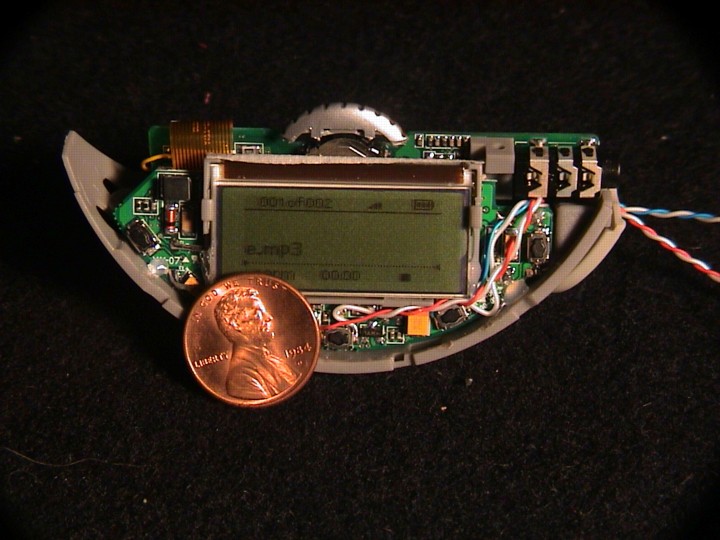


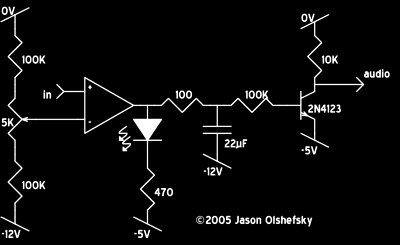
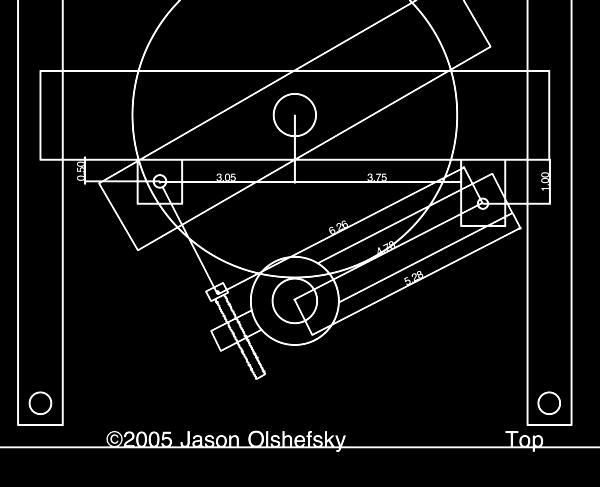
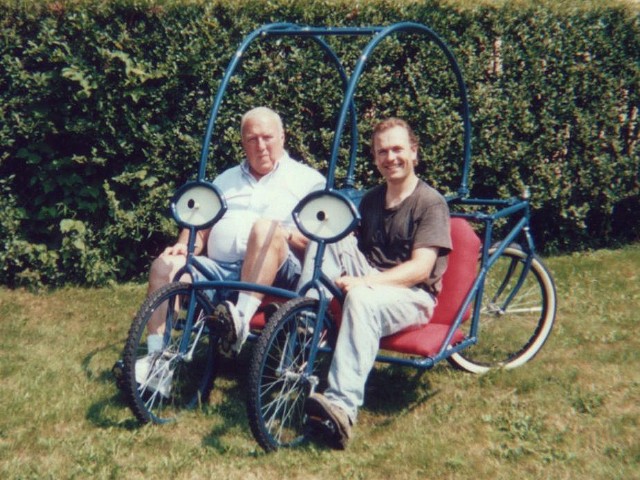
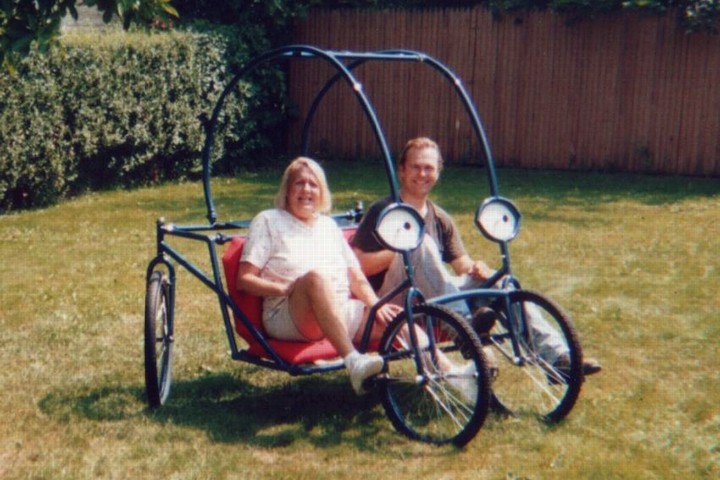
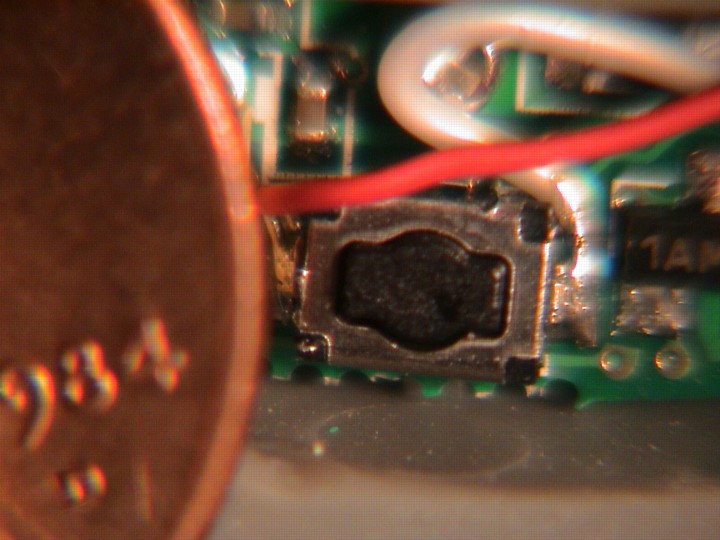
Recent Comments